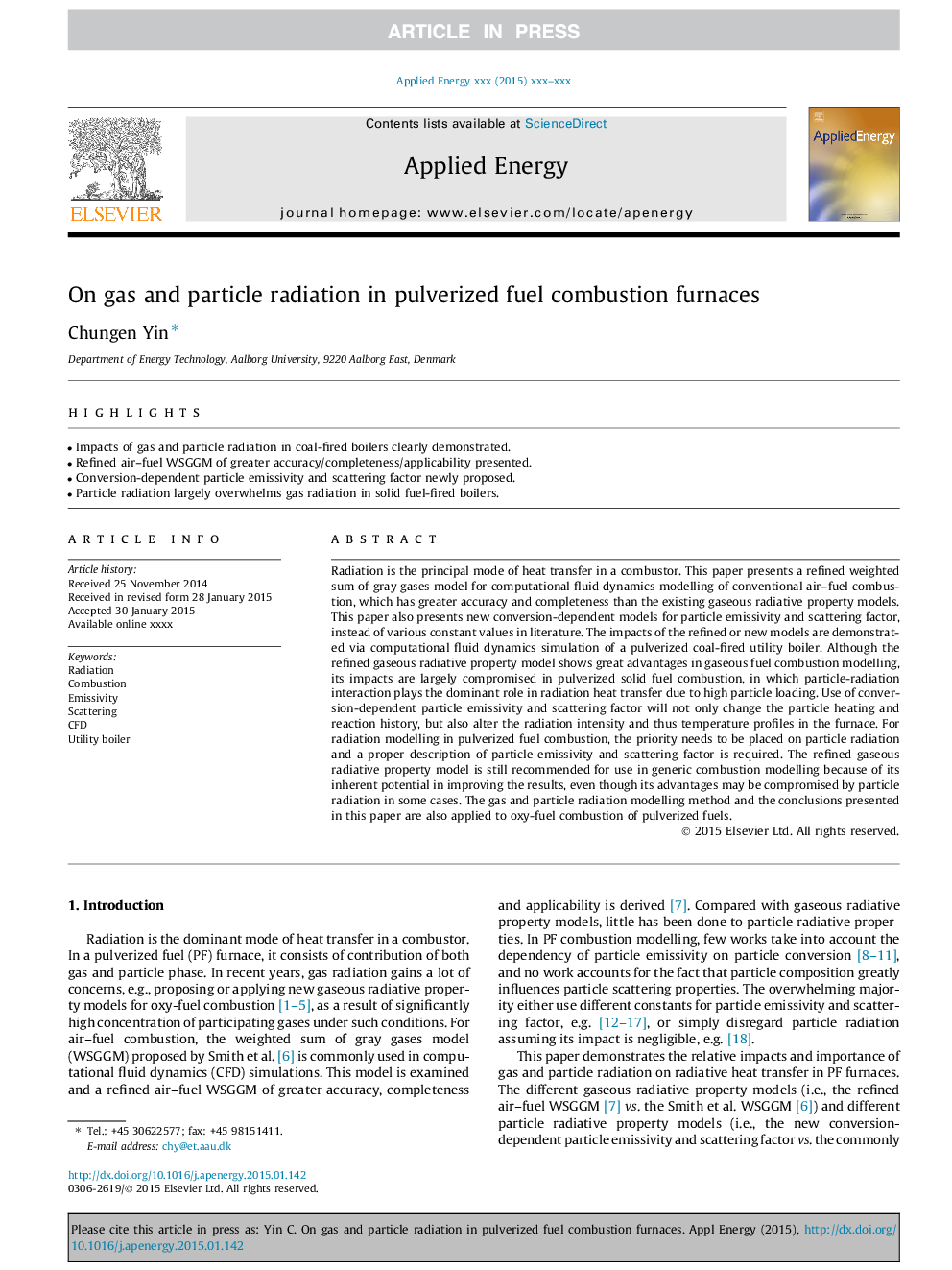| کد مقاله | کد نشریه | سال انتشار | مقاله انگلیسی | نسخه تمام متن |
|---|---|---|---|---|
| 6686017 | 501871 | 2015 | 8 صفحه PDF | دانلود رایگان |
عنوان انگلیسی مقاله ISI
On gas and particle radiation in pulverized fuel combustion furnaces
ترجمه فارسی عنوان
در مورد گاز و ذرات ریز در کوره های احتراق سوخت پودر
دانلود مقاله + سفارش ترجمه
دانلود مقاله ISI انگلیسی
رایگان برای ایرانیان
کلمات کلیدی
ترجمه چکیده
تابش حالت اصلی انتقال حرارت در یک آتش سوزی است. این مقاله ترکیبی از ضریب تصحیح گازهای خاکستری برای مدل سازی دینامیکی سیالات محاسباتی سوخت احتراق هواپیما معمولی را ارائه می دهد که دقت و کاملتری از مدل های امیدهای گازی موجود دارد. این مقاله همچنین ارائه مدل های جدید تبدیل وابسته به میزان انتشار ذرات و عامل پراکندگی را به جای مقادیر ثابت مختلف در ادبیات ارائه می دهد. تاثیرات مدل های تصفیه شده و یا جدید با استفاده از شبیه سازی دینامیکی سیالات محاسباتی از یک دیگ بخار پالایش شده از ذغال سنگ پالایش داده شده است. اگر چه مدل اموال تابش گازی تصفیه شده، مزایای زیادی در مدل سازی احتراق سوخت گاز دارد، اما تاثیر آن در احتراق سوخت جامد به طور گسترده ای آسیب دیده است، زیرا که متابولیسم تابشی ذره در انتقال حرارت تابش به دلیل بارگذاری ذرات بالا نقش مهمی ایفا می کند. استفاده از ماده انتشاری ذرات وابسته به تبدیل و عامل پراکندگی نه تنها تغییر ذرات حرارت و واکنش را تغییر می دهد، بلکه باعث شدت تابش و همچنین تغییرات دما در کوره نیز تغییر کند. برای مدل سازی تابش در احتراق سوخت پودر، اولویت باید بر روی اشعه ذرات قرار گیرد و توصیف مناسب از میزان انتشار ذرات و فاکتور پراکندگی مورد نیاز است. مدل اموال تابش گازی تصفیه شده هنوز برای استفاده در مدل سازی احتراق عمومی به دلیل پتانسیل ذاتی آن در بهبود نتایج توصیه می شود، حتی اگر مزایای آن در بعضی موارد ممکن است توسط تابش ذرات آسیب دیده باشد. روش مدلسازی تابش گاز و ذرات و نتایج ارائه شده در این مقاله همچنین برای احتراق سوخت اکسید شده از سوخت های پودر استفاده می شود.
موضوعات مرتبط
مهندسی و علوم پایه
مهندسی انرژی
مهندسی انرژی و فناوری های برق
چکیده انگلیسی
Radiation is the principal mode of heat transfer in a combustor. This paper presents a refined weighted sum of gray gases model for computational fluid dynamics modelling of conventional air-fuel combustion, which has greater accuracy and completeness than the existing gaseous radiative property models. This paper also presents new conversion-dependent models for particle emissivity and scattering factor, instead of various constant values in literature. The impacts of the refined or new models are demonstrated via computational fluid dynamics simulation of a pulverized coal-fired utility boiler. Although the refined gaseous radiative property model shows great advantages in gaseous fuel combustion modelling, its impacts are largely compromised in pulverized solid fuel combustion, in which particle-radiation interaction plays the dominant role in radiation heat transfer due to high particle loading. Use of conversion-dependent particle emissivity and scattering factor will not only change the particle heating and reaction history, but also alter the radiation intensity and thus temperature profiles in the furnace. For radiation modelling in pulverized fuel combustion, the priority needs to be placed on particle radiation and a proper description of particle emissivity and scattering factor is required. The refined gaseous radiative property model is still recommended for use in generic combustion modelling because of its inherent potential in improving the results, even though its advantages may be compromised by particle radiation in some cases. The gas and particle radiation modelling method and the conclusions presented in this paper are also applied to oxy-fuel combustion of pulverized fuels.
ناشر
Database: Elsevier - ScienceDirect (ساینس دایرکت)
Journal: Applied Energy - Volume 157, 1 November 2015, Pages 554-561
Journal: Applied Energy - Volume 157, 1 November 2015, Pages 554-561
نویسندگان
Chungen Yin,
